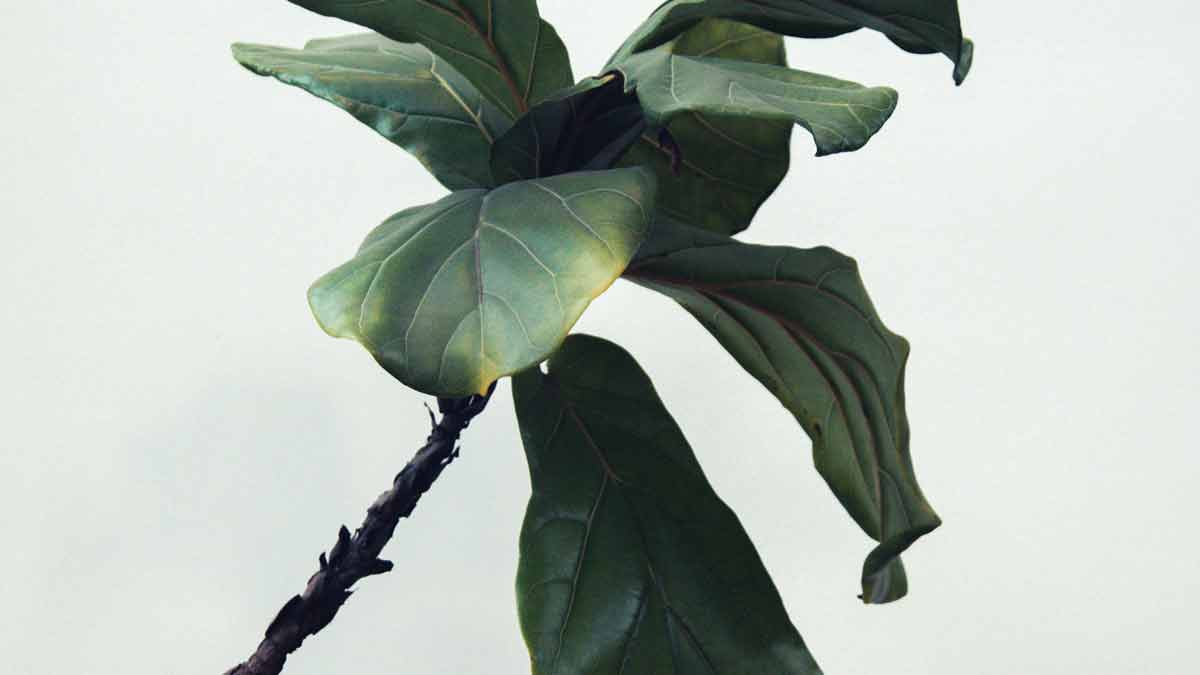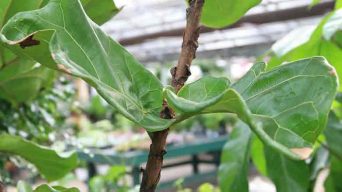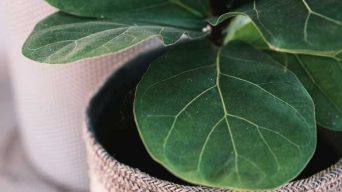Ficus lyrata, commonly known as the fiddle leaf fig, is a popular houseplant loved for its large, glossy leaves.
Unfortunately, this plant can sometimes become leggy, with long bare stems and sparse foliage. A few things can cause this, but it is usually due to the plant not getting enough light.
Thankfully, there are a few simple things you can do to fix a leggy fiddle leaf fig and get it looking healthy and lush again.
Here you’ll find everything you need to know about why your fiddle leaf fig is leggy, how to fix it, and how to prevent it from happening in the future.
What Causes a Fiddle Leaf Fig to Become Leggy?
There are a few reasons why your fiddle leaf fig plant might become leggy.
The most common reasons are:
1. Not Enough Light
Fiddle leaf figs need bright, indirect light to thrive. If they are not getting enough light, they will start to stretch and become leggy to reach the light source.
Fiddle leaf figs need at least 4 hours of bright, indirect light each day.
If your plant is not getting enough light, it won’t be able to produce the food it needs to grow correctly, and it will start to become leggy.
2. Overfertilization
Another common reason for leggy growth is overfertilization. This can happen if you are using a fertilizer that is too strong or if you are fertilizing too often.
Fiddle leaf figs only need to be fertilized once a month during the growing season, using a half-strength fertilizer.
When a fiddle leaf fig tree is overfertilized, it will start to grow too fast. The new growth will be weak and leggy, and the leaves will be small and pale.
Also, high nitrogen fertilizers will promote lots of new growth, but it will be weak and leggy.
3. Lack of Pruning
If you don’t prune your fiddle leaf fig regularly, it will become leggy and unruly. Fiddle leaf figs must be pruned every few months to encourage bushy growth.
When you prune a fiddle leaf fig plant, you should cut the stems by about one-third. This will encourage the plant to produce new growth, which will be fuller and more compact.
4. Rootbound
Rootbound plants are also more likely to become leggy. This is because the roots are crowded and can’t get the necessary nutrients to support the plant.
When a plant is rootbound, it will lose leaves and become leggy to get more oxygen and nutrients.
If your fiddle leaf fig is rootbound, you must repot it into a larger pot.
5. Nutrient Deficiencies
Nutrient deficiencies can also cause leggy growth. The most common nutrient deficiency in fiddle leaf fig trees is nitrogen.
The leaves will be small and pale green if your plant lacks nitrogen. The plant will also become leggy as it tries to get more of this essential nutrient.
However, too much nitrogen can also cause leggy growth. So, it’s essential to get the balance right.
How To Tell If Your Fiddle Leaf Fig Is Leggy?
A few signs will help you tell if your fiddle leaf fig is leggy.
The most common signs are:
1. Long, Bare Stems
It is probably leggy if your plant has long, bare stems with few leaves. This is caused by the plant not getting enough light.
When fiddle leaf figs grow in low light, they stretch out to reach the light source. This results in long and leggy stems.
2. Sparse Foliage
If your fiddle leaf fig has sparse foliage, it is probably leggy. This is usually caused by the plant not getting enough light or nutrients.
When fiddle leaf figs lack nutrients, they produce smaller leaves spaced further apart. This results in a sparse and leggy appearance.
3. Weak New Growth
It is probably leggy if your fiddle leaf fig has weak new growth. This is caused by the plant not getting enough light or nutrients.
When fiddle leaf figs lack nutrients, they produce weak and leggy new growth. The leaves will be small and pale, and the stems will be thin and weak.
4. Drooping Leaves
If the leaves of your fiddle leaf fig are droopy, it’s likely due to the plant being leggy due to insufficient exposure to light.
When fiddle leaf figs don’t get enough light, they cannot produce the food they need to grow correctly. This results in drooping leaves and leggy growth.
The plant won’t be able to sustain its weight and will start to lean over.
5. Etiolated Leaves
When fiddle leaf figs don’t get enough light, the leaves can become etiolated. This means that they are long and thin with a pale green color.
Etiolated leaves are a sure sign of leggy growth. The plant is stretching out to reach the light source.
A healthy fiddle leaf fig will have bright green, oval-shaped leaves. If your plant’s leaves are etiolated, it is probably leggy.
6. Unhealthy and Weak Look
If your fiddle leaf fig is unhealthy and weak, it is probably leggy. This is caused by the plant not getting enough light or nutrients.
When fiddle leaf figs lack nutrients, they will become unhealthy and weak. The leaves will be small and pale, and the stems will be thin and spindly.
The plant will be unable to support its own weight and will start to lean over.
How to Fix a Leggy Fiddle Leaf Fig
If your fiddle leaf fig is leggy, there are a few things you can do to fix it.
1. Move Your Plant to a Bright Location
If your plant is not getting enough light, the best thing you can do is to move it to a sunny location.
Fiddle leaf figs need bright, indirect sunlight to grow properly. If your plant is not getting enough light, it will become leggy.
They need at least 4 hours of indirect sunlight every day. If possible, try to give them 8 hours of indirect sunlight, but don’t put them in direct sunlight as this will scorch the leaves.
An indoor fiddle leaf fig can be placed in a bright room near a window. East- or west-facing windows are ideal, providing bright, indirect sunlight.
If you live in a climate where it is impossible to get 4 hours of direct sunlight, you can supplement with artificial light.
LED grow lights are a good option for indoor plants. They provide the full spectrum of light that plants need to grow correctly.
Outdoor fiddle leaf figs can be placed in a bright, sunny spot but protect them from the hot afternoon sun.
2. Prune Your Plant
You can prune your plant to encourage new growth if it is leggy. Start by removing any dead or damaged leaves and stems.
Then, cut back the long, leggy stems to about 6 inches (15 cm) from the base of the plant. You can also cut back the side branches to encourage new growth.
Prune your plant in the spring or early summer so it has time to recover before winter.
Regular pruning will also help to keep your plant from becoming leggy. Prune it every few months to encourage new growth and prevent legginess.
3. Fertilize Your Plant Properly
Fiddle leaf fig plants need to be fertilized regularly to stay healthy. Too much or too little fertilizer can cause your plant to become leggy.
To prevent this, fertilize your plant every month during the growing season (spring and summer). Use a balanced fertilizer that is made for indoor plants.
Follow the directions on the fertilizer package, and don’t over-fertilize, as this can burn the roots.
Be careful not to use high nitrogen fertilizer, which will promote leggy growth.
4. Give Your Plant a Support
If your plant is leggy, you can support it to help it stay upright. You can use a stake, trellis, or tomato cage.
Drive the support into the potting mix so that it is secure. Then, tie the plant’s stems to the support using soft ties or twine.
5. Repot Your Plant
You must repot your fiddle leaf fig every 2-3 years to refresh the potting mix and give the roots room to grow.
When you repot your plant, use a pot that is only 1-2 inches (2.5-5 cm) larger than the current pot.
Use a well-draining potting mix, and make sure the pot has drainage holes.
To repot your plant, carefully remove it from its current pot and place it in the new pot. Backfill with potting mix and wait a few days before watering your plant.
If the plant is rootbound (the roots are circling the pot), you can carefully loosen the roots before repotting.
How to Prune a Leggy Fiddle Leaf Fig
Pruning a leggy fiddle leaf fig is a great way to encourage new growth and help your plant achieve a more balanced shape.
When pruning, cut just above where a leaf node is present. This will promote new growth from that point, helping to fill out your plant.
You may need significant pruning if your fiddle leaf fig has become significantly leggy.
It is best to cut the plant back to about 12 inches (30 cm) from the soil line. This will encourage new growth from the base of the plant, resulting in a fuller, more balanced shape.
Pruning is a great way to encourage new growth in your fiddle leaf fig and can help to keep your plant looking its best.
Be sure to prune just above where a leaf node is present, and you’ll soon see new growth beginning to fill out your plant.
***
How To Prevent Your Fiddle Leaf Fig From Becoming Leggy
There are a few things you can do to prevent your fiddle leaf fig from becoming leggy:
1. Place Your Plant in a Bright, Sunny Spot
Fiddle leaf figs need bright, indirect light to grow properly. If your plant is not getting enough light, it will become leggy as it stretches towards the light source.
To prevent this, place your plant in a bright, sunny spot. A west- or east-facing window is ideal.
If you live in a hot climate, you may need to filter the light with a sheer curtain or blind.
2. Turn Your Plant Regularly
It is essential to turn your plant regularly so that all sides of the plant get an equal amount of light.
If you don’t turn your plant, it will stretch towards the light source and become leggy.
You should turn your plant every few days to keep it evenly lit.
3. Prune Regularly To Encourage New Growth
Pruning is a great way to encourage new growth in your fiddle leaf fig. By pruning, you can help to keep your plant from becoming leggy.
Be sure to prune just above where a leaf node is present, and you’ll soon see new growth beginning to fill out your plant.
You can prune your plant as often as needed to keep it looking its best.
4. Fertilize During the Growing Season
Fertilizing your fiddle leaf fig during the growing season (spring and summer) will help promote new growth and prevent leggy growth.
Use a balanced fertilizer and apply it according to the package directions.
Be careful not to overfertilize, as this can also cause leggy growth.
5. Repot Your Plant Every Few Years
Repotting your fiddle leaf fig every few years will help to encourage new growth and prevent leggy growth.
When repotting, use a pot slightly larger than the previous one.
This will give your plant room to grow but won’t allow it to become pot-bound.
Repotting fiddle leaf figs can be done in spring or early summer.
Final Thoughts
Fiddle leaf figs are beautiful plants that can add a touch of elegance to any room.
They are demanding plants; there’s no denying that. But you can keep your plant healthy and looking its best with some care and attention.
If you think your fiddle leaf fig is leggy, don’t despair!
You can fix the problem and get your plant back on track with the proper care.







